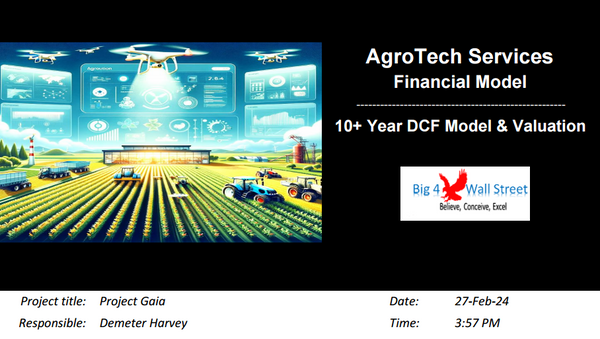Shipping Vessel's Financial Model
Shipping Vessel's Financial Model presents the business case of the purchase of two vessels with the intent of chartering them to generate revenues. The model generates the three financial statements as well as the cash flows and calculates the relevant metrics (Net Present Value, Internal Rate of Return, payback period, cash on cash multiple, enterprise value etc...). The financing options for the project include a standard long term loan as well as an overdraft facility and of course equity funding from investors.
So a quick overview of the model, in the contents tab you can see the structure of the model and by clicking on any of the headlines to be redirected to the relevant worksheet.
On the manual tab you are able to feed the general information for the model such as: project title, responsible, timeline of the model and date and currency conventions.
Additionally there is a description of the color coding of the model in the same tab. Inputs are always depicted with a yellow fill and blue letters, call ups (that is direct links from other cells) are filled in light blue with blue letters while calculations are depicted with white fill and black characters.
There is also a color coding for the various tabs of the model. Yellow tabs are mostly assumptions tabs, grey tabs are calculations tabs, blue tabs are outputs tabs (that is effectively results or graphs) and finally light blue tabs are admin tabs (for example: the cover page, contents and checks).
Guide Tab: this tab helps you to gain a grasp of the main value drivers of the model and understand the critical issues of the business.
Moving on to the Inputs (in yellow whatever can be amended as an assumption): detailed inputs for revenues (vessel characteristics, TCE rates for both handymax and supramax, availability days, and brokerage comission), costs (crew, stores, epairs, maintenance, insurance and administrative), working capital (receivables, payables, and inventory), fixed assets and capex (vessel purchase, dry docks, special surveys), equity financing as well as valuation assumptions (such as discount rates used in the weighted average cost of capital tab or WACC).
In the summary tab you are able to see a high level report with the main metrics and value drivers of the model. It can be readily printed on one page for your convenience.
Calculations: this were all calculations are performed. The revenues from each vessel are calculated based on the available days and whether there is a need for dry docking and deducting the operating costs adjusted for inflation the operating profit is resulting. Based on the assets financed and the gearing of the financing the interest and depreciation are occurring. By using the working capital assumptions the impact of the business cycle is presented. Finally depending on the level of the investment considered the relevant debt financing is calculated (Long term debt and overdraft).
In the Outputs tab: everything is aggregated here into the relevant statements: profit and loss, balance sheet and cash flow.
Moving to the Investment Metrics tab, a valuation is performed by using the free cash flows to the firm and then a series of investment metrics are presented (Net Present Value, Internal Rate of Return, Payback Period, Cash on Cash multiple). Additionally the Debt Service Coverage Ratio and the Loan Life Coverage Ratio are presented.
In the Graphs tab: Various graphs present the investment and operating costs, the revenues per vessel type and the banking ratios (DSCR and LLCR). Then multiple charts present the performance of the project from revenues to bottom line along with debt, assets, working capital and cash flows which results in a valuation on a project basis as well as on an equity basis together with the internal rate of return of the project and payback period metrics.
Checks: A dedicated worksheet that makes sure that everything is working as it should!
Important Notice: Yellow indicates inputs and assumptions that the user is able to change, blue cells are used for called up cells, and white cells with black characters indicates calculation cells.




